|
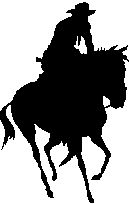
March-May 2008
|
BLACK
HORSE EXTRA
Blame It on Sudden Hoofprints
Of Plotters and Pantsers
More Horse Talk New Black Horse Westerns
Convenient distribution
and sales might be a separate matter, but the London home address of the
Black Horse Western line has proved no handicap when it comes to providing
discerning readers with action-packed novels in the best traditions of the
genre.
It may, in fact, have helped. The authors do not have the responsibility
imposed by a western publisher looking for -- as one back-cover blurb
puts it -- "an epic story of the building of our mighty nation". BHWs stick
for the most part to fulfilling expectations similar to those of the readers
who eagerly sought out the western pulps of an earlier era.
This is not to say that BHW readers would look kindly upon an author who
played fast and loose with history and geography, or that many BHW titles
are not written by United States citizens motivated by other than national pride. But primarily the reader who borrows or buys
a BHW is seeking fiction that has been created to entertain. The term "light
fiction" comes to mind, though not used pejoratively as some people these
days would have it.
In this edition of the Extra, it's our pleasure to invite you to meet Christopher
Kenworthy (aka Walt Masterson), one of the best of the Britons who have
turned their expert writing hand -- he is another former journalist -- to
the Old West. He tackles the job with a combination of flair and respect.
Like many before him, he has afterwards visited places he has written about
with a degree of trepidation that has fortunately proved unfounded.
Chris (or Walt) sets his westerns in a piece of country that will be very
familiar to many of his readers at the present time, since it's also the
setting for a string of fine western stories that first appeared in the pulps
and have now been published in The Complete Western Stories of Elmore
Leonard. This 2004 collection of 30 stories by a master writer was
reissued in paperback last year, was a "recommended read" at the Saddlebums
Western Review blog, and is one anthology that is a must for any western enthusiast's
bookshelf.
Tucson, the Gila River, Fort Bowie . . . places mentioned by Chris in his
autobiographical article and his books can also be found on the map at the
front of Leonard's book. Apaches, cavalry, resourceful civilian scouts and
ladies in peril (but who cope) are likewise elements in common.
Also in this edition, we have more facts about horses from a man who has
known and has worked with them for longer than he has been writing western
novels. Greg Mitchell is another who brings a note of authority to his fiction.
And we pick up a debate-provoking piece from the fine historical-mystery and
thriller writer C. S. Harris. We hope it will form the basis for later discussion
by a panel of BHW writers. All this plus new Hoofprints left by the famous
and not-so-famous. . . .
Your comments and western news are always welcome at feedback@blackhorsewesterns.com
|
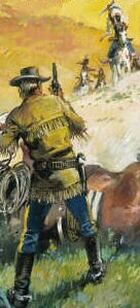
|
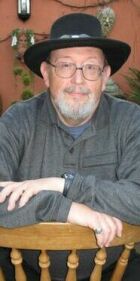
Photo: Freddie Feest
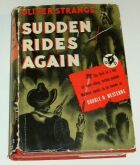
|
How Walt Masterson chased his dreams
BLAME IT ON SUDDEN
When he finds the struggling Wheatley family trying to make it all by
themselves through troubled Apache territory of the Sonora Desert, army scout
John Best begs them to wait for him to guide them. But they set out on their
own and the Apaches strike first.
Now Best finds himself helping the teenager Lucien to rescue his beautiful
sister Emma from a terrible fate. However, the US Cavalry, under a demented,
newly commissioned officer, seems to be determined to complicate matters
instead of riding to the rescue.
It's all down to Best to fight his way through despite the odds.
Back cover
Guns Along the Gila
Discriminating Black Horse Western readers have been warming to the
work of Christopher Kenworthy under the pen-name Walt Masterson. Late last
year BHE tracked him down and requested an interview.
Chris promptly replied, "I was surprised
and delighted to get your email. Yes, I'd be flattered to do an interview.
Since I spent most of my professional life interviewing other people, it
will be a most interesting experience to be on the other end of the process.
I actually wrote my first two westerns back in the 1980s, but left Fleet
Street to go freelance shortly afterwards and, as you will know since you
come from the same background, freelances don't write anything that doesn't
pay top dollar. I retired from professional journalism six years ago, then
came back to the western world a couple of years ago. I enjoy it thoroughly.
. . ."
Recognizing Chris's wide experience, BHE eschewed a rigid question
and answer format, made a few basic suggestions and left it to him to decide
what he cared to tell. The result is this highly entertaining and informative
article. . . .
IT was all Oliver Strange's fault really. In the post Second World War
years, my father and mother, at their wits' end to find a school in which
I would not be swamped by the local lads, sent me off to an English boarding
school perched on the end of the Pennine mountain chain in the mountainous
wilds of Derbyshire. The teaching was gentle, the headmaster, a saintly
man, did not believe in corporal punishmant, and what else can you do
to someone in a boarding school? You can't keep him in, because he already
is. So I did not believe in doing anything I did not actually want to do.
But the school was in a kind of minor stately home. It contained a
magnificent library, and the library contained wall after wall of books.
A child thirsting after knowledge could have done a PhD on the contents
of that library. I thirsted after adventure, and I found it in the great
adventure wrtiters. I read Walter Scott, H. Rider Haggard, everything I
could find about King Arthur and his court and so on. And I discovered the
Sudden novels of Oliver Strange. Night after night I lay in my dormitory
bed, reading by the light of a lamp outside the window, and riding the range
with Sudden.
Sudden led me to Zane Grey, and on and on and on. Louis L'Amour and
I made contact quite a lot later, but we bonded. By this time a professional
journalist in Fleet Street, I did the grand tour of the street, working
for the Daily Express, the Evening Standard, television programme magazines,
the early television column of The Sun newspaper. I managed to interview
a stream of authors parading through London, and I shamelessly looted
their brains and expertise.
|
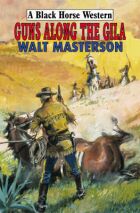

|
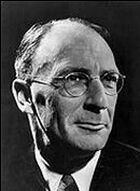
C. S. Forester
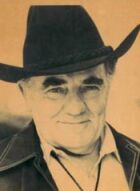
Louis L'Amour
|
C. S. Forester ( I love seagoing adventure, too, of course; Hornblower
and I hit it off splendidly) told me: "Write the books you would want
to read," so I did. I wrote a series of four seagoing adventures set in
the Anglo-American war of 1812.
When I discovered Louis L'Amour, and found he had hundreds of titles
in print, I thought I had achieved paradise. I worked my way steadily
through every word of his that was available at the time. Indeed, so prolific
was he that I am still finding, decades later, Louis L'Amour titles I have
never heard of.
Finally, I actually met Louis. I could not believe my luck. We had lunch
at one of London's top hotels and I don't know about him, but so far as
I was concerned, we bonded. This big man -- he was in his later years
by this time, but still looked as though he had been hacked out of granite
-- sat and poured out his own history and what amounted to a blueprint
on how to write westerns. He even paid for the lunch, against my startled
objections, I swear. I can't remember what we ate, but I consumed what
he said greedily and and laid it all on paper.
There is a curious snobbery about westerns. Literary critics and those
who aspire to letters dismiss them as "pulp westerns". Well, sucks to
them. The late, great Sir Winston Churchill loved them, I am told, and
he was a literary talent of awesome proportions. Me, I'm with Winston.
|
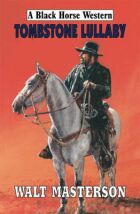
|
|
Promptly
two dust coloured shapes popped up and started their jinking runs, one of
them providentially in his sights, and he saw the blood fly when his shot
hit the man in the head. He went down like a sack of potatoes, though his
companion dived into the ground several yards closer. At this rate they would
be all over him in ten minutes and he knew that he had to move. Trouble was,
so did the Apaches and they began to speed up their charges.
|
|
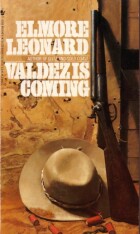
|
A good western contains everything an adventure story should. It has
a strong action line. It has heroic heroes and villainous villains. It
is, I sometimes think, the last refuge of simple morality. In a good western,
good triumphs. Elmore Leonard's Valdez is Coming is an
outstanding one -- a brutal and powerful man surrounded by hired guns and
bully boys is brought down by a retired Mexican scout who, through his courage,
expertise and sheer doggedness, reduces the villain's band of hired thugs
to a basic minimum, steals his woman and finally humiliates him in front
of the remains of his gang. Good old Valdez! He gets the girl, too.
I asked Louis L'Amour why the West seemed full of tough men on both sides
of the law.
He pointed out that just to get to the western territories before the
opening of the railroads meant months of travel. Most of the people who
started out from the frontiers of civilization walked for thousands of
miles, with their homes in wagons, their wives and children with them.
Kids were born on the trail. People got married.
|
|

Martha Summerhayes
|
Just getting there could kill you. I read the wonderful Vanished
Arizona, Martha Summerhayes' magical first person account of life
as a junior officer's wife in Arizona in the 1870s and 1880s. As a young
bride, she had to get to California, take a steamer to
the Gulf of California, and a paddle steamer up the Colorado to Fort Yuma.
Conditions for the gently born girl from the East Coast were frightful.
At one time during their service in Arizona Territory, she gave birth to
her baby and then promptly had to travel across Arizona in an Army ambulance
-- wagon with springs -- through territory ranged by vengeful Apaches. Her
husband gave her a small handgun and told her to use one cartidge for her
baby and the other for herself if he should be killed in a skirmish. The
ambulance, incidentally, was not provided because she had just given birth.
It was the only available form of transport for women at the time.
Welcome to Arizona, Mrs Summerhayes. Enjoy.
What women they were, the ones who plodded across the continent to make
new lives in the West! They faced everything their husbands faced and more.
And when they got there, the hard work really started. There are accounts
of women pulling their husband's plough. Now that's a woman!
|
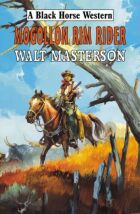
|
|
An hour later he was looking down into the contaminated water of the seep.
There was a dead pony lying half in and half out of the water, its throat
slit and a boken cannon bone testifying to the reason it had been sacrificed.
There was no need for the Apache to ambush the site. By their act they considered
they had either condemned their pursuers to death or forced them to break
off the pursuit and return to the last water source.
|
|
|
|
All this knowledge about Arizona and New Mexico came my way when my
son, Matthew, who is an astro-physicist (you don't need to know this but
I like saying it) went to Tucson to work. He has been there for nearly ten
years, now, and we visit him as often as we can, but in any case at least
once a year.
Because of Matt I actually got to visit places I had only read about,
or seen John Wayne defending with unerring aim. My first two westerns,
Carnigan's Claim and A Hot Day In Hammerhead,
were written and originally published under the pen-name of C. Kay (geddit?)
and more significantly, written before I had actually been to the States
at all. We drove around Arizona with my heart in my mouth because I was
sure my ignorance must be apparent in the books . . . and found to my astonishment
that thanks to dear old Duke and his co-stars I hadn't made any glaring
bloopers.
But actually being able to go there brings the whole of the South West
alive in a very special way. The first revelation was that Arizona really
is like that! The Painted Desert really does look as though some
gigantic amateur decorator has been splashing the rocks with weird colours.
The Grand Canyon truly is beyond words. The Sonoran Desert, where I set
Guns Along the Gila, has not changed since the
only way to get to Fort Yuma was to ride a horse, drive a wagon or walk.
Well, okay, there's a magnificent highway through it now, and Yuma is surrounded
by irrigated fields where they grow lettuce, for heaven's sake, by the
square mile.
There really are forests of saguaro cactus -- the ones like men standing
with their hands up -- but they stop growing somewhere north of Phoenix
and a place called New River. There's a growing community there now, but
at one time there was just a refuge for travellers going north to Prescott
and the fort at Camp Verde. General Crook used Verde as one of his bases
during his campaigns against the Apaches. His main headquarters was at
Fort Apache though. It is still there, in a setting of savage beauty,
and so are the Apaches. You can visit Crook's home and stand on the parade
ground. The Apaches watch you with unreadable eyes. It can be unnerving.
It is, after all, their homeland.
|
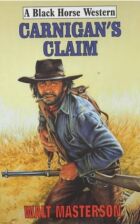
|
|
"Between
here and Yuma, there's a whole lot of Sonoran Desert. That's bad. In that
there Sonoran Desert there ain't nothing that doesn't sting or poison or
bite."
|
|
|
If you want to go to another fort which really controlled the end of the
Indian wars, you can still see its remains. It is Fort Bowie in Apache Pass
to the south. The reason for the fort is Apache Spring, which was used by
both the Apaches and the white migrants passing through, and constantly fought
over. Cochise used to live nearby and it hasn't, so far as I can make out,
changed at all. The valley which is Apache Pass has a gentle, rising path
up to the spring, and the remains of the fort are beyond it. I've been there
and drunk at that spring, despite the notice advising against it. I couldn't
resist the temptation.
The reason I love Louis L'Amour's work is that he was a genuine westerner
and it shows. Strip out the guns and the horses and what you have in so
many of his books is a story which would be interesting in any setting.
His heroes are real men, and occasionally make real mistakes. When they
get shot -- and they frequently do -- it hurts them and they bleed. Set
afoot in the desert, Hondo Lane doesn't miraculously come across a straying
Indian pony, he humps his saddle and his gear for days before he arrives
at an isolated ranch and then he has to buy a horse and break it himself
before he can get going with his despatches. And, incidentally, meets the
heroine and love of his life.
|

|
|
All he had to do was wait and the night would reveal itself to him. Very
slowly it did so. First the faraway creatures emerged from the black and
silver. A coyote trotted busily along the trail below, stopping now and again
to raise its head and listen and sniff the air. It could probably, Best knew,
smell both him and the horse. What tiny wind the night allowed to whisper
over the land carrried a river of scents on it, rich and pungent to the wild
nose out there.
|
|
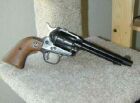
Ruger Single Six
|
Why choose Walt Masterson as a pen name? "Walt" is a friend of mine
in Tucson who once worked as a guide in Tombstone, so he actually did walk
down Allen Street wearing a Colt on his hip. He has a fine collection of
weapons, including a Winchester carbine, and Colt .45, so I know what they
weigh and how they feel. In my youth, before privately owned handguns were
outlawed in Britain, I owned a Ruger Single Six and went target shooting
every week. Better than carrying a gun in Tombstone. The targets don't shoot
back.
"Masterson" is in honourable memory of Bat Masterson who was in Tombstone
with the Earps and went on to become a newspaperman. I was slightly embarrassed
to discover there really was a Walt Masterson, related to Bat, but I
don't think I have done anything to embarrass him.
I have a whole collection of books about the history of the South West,
and a pile of newspapers and magazines both from the period and recalling
it. Many of my stories -- Guns Along the Gila is one -- are
based on real stories of real people. Considering what they did, and how
they lived and survived, it is impossible to exaggerate.
They haven't changed much either. The cowboys in the white hats --
and yes, they do wear them, though these days they often ride pickup trucks
rather than mustangs -- talk the way they do in films, and wear blue jeans
and western shirts. Why not? They are cowboys and they live in the West.
I know, I know, I go on about the West. Its brief history fascinates
me, the country itself draws me, the people charm me.
And now, if you will excuse me, I must get back there. There's
a small wagon train crossing the Painted Desert on the old Mormon Trail,
running into trouble with four crooked brothers and I need to get the
hero down out of the mountains to give the people a hand. I have a feeling
gunplay is in the offing. . . .
|
|
|
|
|
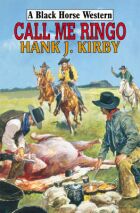 Under many brands. Under many brands.
|
A new set of western tracks
HOOFPRINTS
Veteran author Keith Hetherington, of Queensland, Australia,
tells Hoofprints, "Ran into a bloke I haven't seen for a while in the local
library and he told me he picked up a Brett Waring Cleveland paperback from
a book exchange last week -- 'Hey, mate! Thirty bloody years old and she's
still a good yarn! You better tell me the pen-names you use now.' I did,
and he already had a Jake Douglas BHW in his bag and went off to look for
more under my pseudonyms. Bit of a lift . . . in fact, apart from movie
sales, just the thing to pick you up." Regular BHW readers won't need reminding
that Keith's other BHW bylines are Clayton Nash, Hank J. Kirby and Tyler
Hatch. And as reported here in our December 2006 number, a nickname he also once
had was "Ringo", which pops up in the title of his latest book. Publisher
John Hale describes Call Me Ringo as "a splendid western". This is something
of a relief to Keith since he put it together last (southern) winter while
battling a bad case of flu and longer-term health woes despite
having had an annual anti-flu vaccination. "I've never felt so low,"
he said then. "Don't know where I am half the time or what I'm doing."
As in a good Hetherington yarn, all's well that ends well!

|
|
|
Actor Sam Elliott has carved a niche playing
men who adhere to a cowboy code of honour. He told Susan King in an interview
for The Scotsman how his childhood was spent in suburban Sacramento but early
roles in westerns kept coming his way. "I have no explanation for it.
It's not like I went after them necessarily. . . . My family on both sides
for several generations all hailed from Texas. My dad was with the Fish &
Wildlife Service and got transferred from West Texas to Sacramento. I was
born the year after they got there. I never heard the end of the fact I
wasn't a Texan." But Sam spent a lot of time around ranchers and
real-deal cowboys and sheepmen. "There is something about that sensibility
in general that appeals to me." Today Elliott lives in the wilds
of Malibu and owns a ranch, complete with horses, south of Portland,
not too far from where his 92-year-old mother resides. Meanwhile, at
Hollywood.com, staffer Scott Huver noted that 2008 marked the 63-year-old
actor's fourth decade in films and television. "You had a good,
long association with author Louis L'Amour -- projects like The Sacketts,
The Shadow Riders and Conagher. Any more of his works that you'd like
to do?" Sam replied, "There are a couple more . . . I think Tom Selleck
has the rights to one of them. . . . I love L'Amour's stories and his
characters. They're so classically American westerns and cowboys. That's
the kind of stuff I really love doing. That's kind of the ultimate escape
on some fantasy level."
|

When is a Texan not a Texan?
|
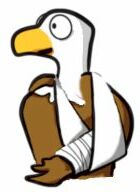 A broken wing.
A broken wing.
|
Chris Kenworthy found putting the finishing touches to his fine leading
article for this edition of BH Extra a somewhat challenging exercise. Just
days before Christmas, he fell and broke his left arm. This gave him plenty
of time to read his emails at what should have been a more active time of
the year -- "I'm restricted to the house and my right hand" -- but among
the disadvantages were the many minutes it took him to prepare replies to
the messages. He hopes to contribute to BHE again, "hopefully a good deal
faster than currently . . . this reply is being typed with one finger at
a pace which would bore a snail with its ankle in plaster." Fortunately,
the next Walt Masterson BHW, Gunfight at Dragoon Station, was all complete
and is safely scheduled for publication on May 31.
|
|
|
Robert Duvall is another actor closely associated with westerns. He starred in Open Range and two of television's
most celebrated treatments of the genre, Lonesome Dove and Broken Trail. An interviewer for the Basingstoke Gazette asked him, "Where does your love of
the genre come from?" He said, "It's our deal. The English have Shakespeare, the French have Molière
and the western is definitely ours. When I was a kid I went to my
uncle's ranch in Montana for two summers -- he had a big cattle and
sheep place out there. And you know, when I first went to Hollywood
I would take out a horse every day -- bareback, English saddle, western
saddle -- and I learned to jump a horse, so I would have a seat on a horse,
because most actors can draw a pistol but they can't ride a horse. So I
wanted to do westerns and it served me well. So I think westerns are our
thing. People say they don't sell, but they do sell and, as soon as you
make them, they say, when are you going to do another one? In England, they
love westerns, wide-open spaces and all that. I just like doing them."
He laughed. "At the end of my career I thought maybe I could do a gunfighter
in a western who is mute, so I wouldn't have any lines."
|
 "Definitely ours."
"Definitely ours."
|
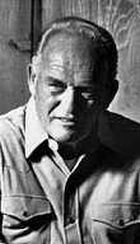
The late Mr Paine.
|
Hoofprints has quoted in the past at least one brother writer who believes
his BHWs will allow him to achieve a sort of immortality. What better,
then, than to go a step further to what, at first glance, looked suspiciously
like reincarnation and a sex change! In the December issue of its magazine
Roundup, Western Writers of America featured a review by Linda Wommack
of a Five Star publication, Man From Durango; A Western Duo by Lauran
Paine. As David Whitehead has told us in an informative BHE article
(December 2006), visit any library in Britain and Paine (1916-2003)
is still the best-represented western writer on the shelves -- thanks
largely to a record output of BHWs under his own name and dozens of pen-names.
The Roundup review told its specialist audience, "Lauran Paine is undoubtedly
one of today’s greatest Western fiction writers. With dozens of books to
her credit, including the bestseller Open Range, also a major motion picture
hit, the latest book, Man From Durango, gives fans two tales in one volume.
. . ."

|
|
|
At the website of the Madison (Wisconsin) Public Library, Robin of Meadowridge
reviewed Cormac McCarthy's All the Pretty Horses and added in a footnote:
"I had always thought of westerns as, well, just westerns, until a library
tour guide informed my group that only older men read westerns. And furthermore,
that her library (not a library in our system, thank goodness) was only
allocating one spinning rack to western paperbacks because 'everyone
who reads westerns is going to be dead soon'. I bristled, and still bristle when I recall it eight years later."
|
 Madison library corner. Madison library corner.
|
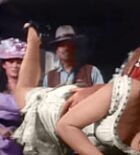 Lil . . . is she PC?
Lil . . . is she PC?
|
In a lively debate at the Piccadilly Cowboys forum, Maestro, of Illinois,
told Steve M, "My opinion on Ralph Compton westerns -- thumbs down! The writing
is juvenile to the extreme and the books are filled with modern-day political
correctness -- rootin tootin female gunfighters galore! Something that
never even came close to reality back in the Old West. . . ." Mick Keetley,
of Derby, England, responded, "The ones I have read do not have female gunfighters."
Then BHWs' Chap O'Keefe, maybe with an eye to championing Misfit Lil,
pitched in. "I can't speak for the works of any of the 'Ralph Comptons',
but rootin' tootin' female gunfighters sound like a great chance for some
fun to me. And I can't agree that they have much to do with modern-day political
correctness. Tough western heroines have a tradition that dates
right back to the Beadle Dime Novels featuring Hurricane Nell, Calamity
Jane and others. For this genre, how much further can you go? You're quite
right that sassy ladies weren't part of the everyday reality of the Old
West, but was much of what we read and enjoy? For myself, I find writing
the Misfit Lil series has given me a chance for a break from more
seriously researched books like Peace at Any Price." Dipping into the latest Lil, Misfit Lil Hides Out, Hoofprints finds a chapter beginning, "It
seemed doubtful the ball at Fort Dennis could afford any excitement more
irregular than the spanking of Lilian Goodnight." A gruesome murder is then
committed. Politically correct? Hmm. . . .

|
|
|
Demand is growing for large-print books, Johanna King reported in the Albuquerque
Journal (New Mexico). "Whether travelling, exercising, suffering from waning
eyesight or just plain tired, large-print books may prove to be a saving
grace for readers. The large typeface in the books makes them easier to read,
and not just for the visually impaired. Large-print titles are gaining
popularity among commuters and travellers being jostled by planes, trains
and cars, say librarians and booksellers. They note the books are also
the choice of office workers whose tired eyes can’t focus well after spending
all day staring at a computer. And they’ve become part of the exercise
arsenal for gym enthusiasts who read while working out on treadmills and
stationary bikes."
|
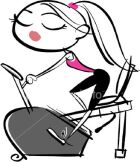 Time for an eye-opener?
Time for an eye-opener?
|
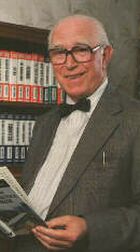 Thorpe's top-shelf westerns.
Thorpe's top-shelf westerns.
|
The distinctive T&P tepee stamp on magazines imported by the Thorpe
and Porter firm of Oadby, Leicestershire, was a familar sight in Britain in
the 1950s and gave many readers their first taste of western and other pulp
fiction from America and Australia. After principal Frederick Thorpe
retired from the business, he hit on an idea for helping elderly and impaired-sight
readers. In 1964, he founded large-print book publishing in English, reprinting
old favourites in editions about twice the size of the regular books.
The books had no cover art and were color-coded to indicate categories
-- like orange for westerns, black for mysteries -- a convention that
has survived on the spines to this day. In 1969, Thorpe's Ulverscroft company
began to retypeset the books in 16-point type and put them in normal-size
bindings, increasing acceptance by ordinary public libraries. Thorpe
became a large-print ambassador, travelling the English-speaking world promoting
the provision of large-print books for seniors. Today, Ulverscroft continues
to issue westerns under the Linford and Dales imprints -- a large percentage
being reprints of the best recent BHWs.
|
|
|
Just published is newcomer Matthew P. Mayo's second BHW novel, Wrong
Town, in which homely-faced hero Roamer strives to save the Rocky Mountain
township of Tall Pine from tearing itself apart. Matthew is also the editor
of, and a contributor to, Where Legends Ride, a 14-story anthology published
by a group of writers operating under the badge Express Westerns. And he
has his very own, tastefully designed author website. But Hoofprints can
only wonder why his home page -- at which he offers his services as an editor
and writer -- features a photograph of a chimpanzee working at an old-fashioned
manual typewriter. Is it a picture of the proud author? What he expects
to be an uncle of if you take up his offer? Or is it a subtle suggestion that
anyone who pays peanuts must expect a monkey? The puzzle's
too deep for Hoofprints! We'll be looking out for Matthew's books instead.
. . .
|
 Monkey puzzle.
Monkey puzzle.
|
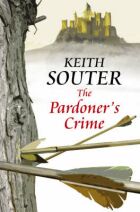
Different outlaws.
|
Several BHW authors have been moving into new stalls at the Robert
Hale publishing stable, making forays from the Old West on to the crime
and historical scenes where the company is strengthening its presence.
They include John Paxton Sheriff (aka Jack Sheriff, Matt Laidlaw, Jim Lawless
and Will Keen), Keith Souter (aka Clay More) and Jean Rowden (aka Eugene
Clifton). Keith Souter's latest title is The Pardoner's Crime. It is the
time of outlaw Robin Hood and Sir Richard Lee, Sergeant-at-Law, has been
sent to Sandal Castle by King Edward II to preside over the court of the
Manor of Wakefield. Within hours of his arrival, Sir Richard and his assistant,
Hubert of Loxley, are forced to investigate a vicious rape and a cold-blooded
murder. . . . It appears Keith is staying closer to home. He graduated in
medicine from the University of Dundee and has worked as a family doctor
in Wakefield for many years. He tells us, "I live within arrow-shot of historic
Sandal Castle."
|
|
|
Author Ray Foster (aka Jack Giles) had a great 2007, getting back in the
writing saddle after an eight-year hiatus. Virtually on Christmas Eve, he
emailed us, "Just today heard back from Robert Hale -- there will be a new
Jack Giles western titled Lawmen. Absolutely, thrilled to bits. What a
Christmas present. . . ." For those who do not already know, Ray explains
for BHE in his own words: "Jack Giles, figuratively, 'died' in 1999 halfway
through two books -- whether he gets 'resurrected' is a matter of debate.
In 1999 I had a stroke -- and, although I can walk, talk and do things
that 'normal' people can do, I did lose near enough 30 years of memories.
Of course, one of the first westerns that I read was a Jack Giles and my
wife, gently, had to break it to me that I had written the book. The story
of how I came to write westerns was documented; the original contracts were
in a file along with a couple of letters from Terry Harknett [aka Edge author
George G. Gilman]."
|
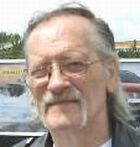
Jack rides again.
|
|
|
|

|
Finally! The low-down on how writers work
OF PLOTTERS AND PANTSERS
BHE has borrowed advice for writers from Candy's Blog before. CANDICE
PROCTOR writes a Regency mystery series under the name of C. S. Harris and
thrillers as one half of Steven Graham. Her blog posts contain considerable
good sense for all writers. They also widen our appreciation as readers.
Recently,
Candy said she thought respect was "the single most important aspect of powerful
writing . . . . Respect for one’s craft, respect for oneself as a writer,
but most importantly, respect for one’s readers. This is what drives me to
spend days researching an elusive fact, that inspires me to deepen my characters,
to polish my prose, to close up my gaping plot holes, to plumb the depths
of each scene’s emotional potential. It’s because I respect my readers and
my craft that I strive always to avoid the overdone, the hackneyed, the melodramatic;
that I don’t let myself take the easy way out, that I always push myself to
reach that little bit further."
Here is a past post on Plotting that BHE hopes it will be possible to follow
up with a panel discussion among BHW writers.
WRITERS typically fall into one of two camps: those who plot their books
before they begin, and those who do not.
The latter types like to live dangerously and fly — or rather, write —
by the seat of their pants. Believing that advance planning kills their muse
and destroys their interest in a story, they jump in with little idea of
where their story will go. In a romance, they’ll start with a “cute meet”
and fumble their way forward from there. In a mystery, they don’t know ahead
of time who will turn out to have committed the murder or why; sometimes
they’re not even sure who — amidst all the characters magically appearing
on their pages — will actually be the one to fall victim to a foul deed and
start the mystery rolling.
|
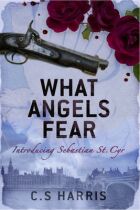
|
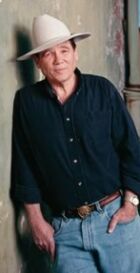
James Lee Burke
|
In the hands of a master, this “winging it” approach can be highly successful:
James Lee Burke, for instance, says he can never see more than two or three
scenes ahead as he writes, yet what he produces is brilliant. Unfortunately,
with many “Pantsers”, the result is all too often a wandering storyline,
gaping plot holes, an unbalanced story arc, and a host of other dastardly
results.
As you can see, I’m not a fan of this approach. Yes, it can work, and
work well. Yes, there are bestselling writers who use this approach. But
then, there are a lot of books published every year — including bestsellers
— that I find just don’t hold my attention. And you know what? I’ve discovered,
after a little bit of digging, that most of the writers whose books I put
down are Pantsers rather than Plotters. Now, that might tell you more about
me as a reader than anything else — unless I’m reading something beautifully
literary, I like a tightly knit, well-constructed book with a good story arc.
There are obviously many readers who don’t mind a more rambling, casual,
disjointed tale. The Pantsers are for them.
|
|
|
If a recent discussion on the DorothyL mystery listserv is anything to
go by, a surprising number of mystery writers — like romance writers — use
the Pantsers’ approach. There seems to be something about the act of plotting
out a story in advance that kills their joy in writing it. Some Pantsers
do massive rewrites to pull their ramblings into something cohesive — and
publishable. Others seem to be able to plug into their subconscious so successfully
that they claim their books require almost no rewriting. There’s a lot of
New Age-like talk about whether Plotters are left-brained or right-brained,
but the discussion is seldom flattering to the Plotters. Plotting is often
portrayed as plodding and pedestrian; the antithesis of creative; Pantsers
typically see themselves as the truly creative ones, giving birth to an
almost mystical product.
Frankly, I’ve never been able to decide if I’m left or right brained.
I am very analytical, very methodical — I was, after all, an academic. Yet
I’m also very creative — for many years I planned to become a professional
artist. One of the reasons I like plotting my books out in advance is that
it gets all that analytical stuff out of the way, so that when I sit down
to actually write, I can just relax and let the story flow without worrying
about structure.
Incidentally, there is a third kind of writer. These people never plot
anything out on paper, and they don’t use notecards or post-it notes. But
they’ve given so much thought to their story before they begin that they already
know their story arc, their key scenes and major characters. They may not
be plotters in the traditional sense of the word, but I don’t think they
can really claim to be writing by the seats of their pants, either. They
just have amazing memories. I’m not one of them.
|

|
|
|
|
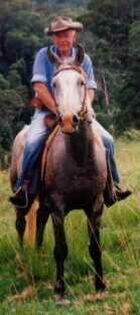
|
Greg Mitchell checks the facts
MORE HORSE TALK
(With quotations from the classic book The Log of a Cowboy by Andy Adams, first
published in 1903. Greg Mitchell says, "His book is a very good one
with plenty of reference material for writers. The size of some of those
old trail herds was amazing. The biggest mob of cattle I ever worked with
was slightly over 1,500 head and that was roughly a mile from the leaders
to the tailers. Adams' herd was 3,000 head, so on the road they would stretch
out to nearly two miles.")
THE cowboy's horse may have been his best friend but it can be a western
writer's worst enemy if it is wrongly described or used for doing the impossible.
Get the horse details wrong and they can destroy the author's credibility.
And don't think that most readers won't pick it up. Many western readers
are horse people and though riding styles might differ from country to country,
some facts about horses remain the same.
Here are a few fictional clichés and the reality.
Riding horses
As mentioned in the December 2007 edition of Black Horse Extra, stallions
are poor choices for general riding. They can be bad-tempered and if a mare
in season is nearby many are difficult to control. Good stallions were kept
mainly for breeding purposes and were often too valuable for day-to-day knocking
about. While an outlaw might steal one to escape the law or to use for one
specific task, it would be too dangerous to keep the horse for any length
of time. The task of taming a mature wild stallion would be beyond the ability
of the average rider and even when tamed, such animals would still be difficult
to handle and unreliable in performance.
Likewise, draughts are not much good because their body shapes are wrong
for riding. The problem of a heavy rider is not solved by putting him on a
draught horse. A properly built riding type, though hundreds of pounds lighter,
is more capable of carrying weight at speed. It is not a case of the bigger
the horse, the stronger it is. Conformation and breeding are the most important
factors for weight-carrying and endurance.
While the six-feet-two traditional hero might ride a 17-hand horse, such
animals were not common in the West, nor were they any better because of their
size. A hand measurement is 4 inches or about 10 centimetres. A horse's height
is the distance between the sole of the forefoot and the top of the wither
(where the neck runs into the shoulders). A pony is a horse below 14 hands
2 inches, although cowboys often referred to all horses as ponies. Most working
ranch horses would be somewhere between 14 hands 2 inches and 16 hands.
To carry weight at speed, a horse has to be built in a certain way. The
draught horse is not designed to be ridden and will fail quickly if galloped
under a rider. A properly built riding type of 15 hands is a better weight
carrier than the draught.
|
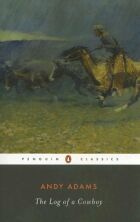
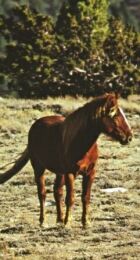
Wild stallion
|
|
At
no time in my life, before or since, have I felt so keenly the parting
between man and horse as I did that September evening in Montana.
|
|
|
I read one western where a large villain rode a Clydesdale draught. It might
have been strong when taken at a walk but would be too slow, too clumsy and
lack the endurance for a true villain's horse. It is a bit hard to lay waste
to the countryside on a horse that is slow and stumbling and scarcely able
to gallop 300 yards.
Arab horses, Morgans and Quarter horses are not tall and 15 hands is
considered a fair height for such breeds. Very tall horses usually had Thoroughbred
or draught in their breeding.
Mustangs had a reputation for toughness, and some of these were only
about 14 hands but they were not particularly good weight-carriers because
of their small size.
Travelling
When fit, a good riding horse can easily cover 40 miles per day but to keep
up that rate over long periods, it needs to be hand-fed and rested for at
least one day a week. Horses are capable of covering much greater distances
in a single day, but it takes its toll on them and sometimes they are not
fit for the next day's work. A good travelling pace that kept the horse in
good condition was 5 miles per hour. It does not sound like much but takes
a lot of trotting and cantering to maintain that rate.
The Pony Express rode at a very fast rate but used, lightweight riders,
specially selected, well-fed horses, and frequent changes of mounts.
Stagecoaches averaged between 9 and 10 miles per hour under normal conditions,
with horses changed every 12 to 15 miles.
Flanks
These really get writers into trouble. In military terms, the flanks are
simply the sides but with an a horse they are a specific place. Flanks are
the areas between the last ribs and the hind legs.
Horses are sensitive around the flank and most riders do not spur them there.
I read of one hero who rode hard "with knees pressed into the horse's flanks".
To do this he would need to be sitting behind the saddle and the horse would
probably buck at such treatment.
Most spurring is done on the horse's sides, not its flanks. A long-legged
rider or one with long-necked spurs could reach the flanks but that is hard
on the horse. A light touch with the spur on the side usually produces a
better result.
Neither horses nor cattle are branded on the flanks.
|
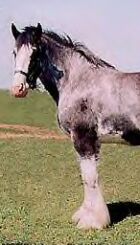
Clydesdale
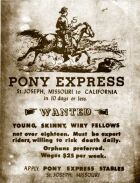

|
|
For on the trail an affection springs up between a man and his mount that is almost human.
|
|
|
Steering horses
Western stories frequently have riders "kneeing" their horses in all directions.
Horses are steered by the reins or sometimes by shifts in weight, touches
from the heels, or even the calf of the leg but never by the knees. Knees
are mostly used for gripping but not for steering.
Reins are traditionally held in the left hand when riding one-handed. This
not only leaves the rider's right hand free to do other things but allows
greater control over the horse when mounting and dismounting.
Riding styles
Working riders ride differently to today's show-oriented riders and what
is correct in one place can be downright dangerous somewhere else. The bridle
is the main means of control and with horses raised on the open range, it
is the first thing on the horse and the last thing off for safety reasons.
In England and Europe, horses are usually tied up with halters for saddling
so the saddle goes on before the bridle. Authors often mention horses being
saddled in the wrong order.
In England and Europe, riders dismount by removing both feet from the stirrups
and sliding off. This style is fashionable because of small women riding
big horses who have too far to step down from the stirrup, but no self-respecting
cowboy would do it because of loss of control and the chance of being cow-kicked.
Range-raised horses that are feeling energetic or frightened sometimes kick
forward with the hind leg, as a cow does, and will catch the rider who has
just slid off. Others will try to pull away and if they succeed can really
flatten and possibly kill a rider with a straight-back kick from both hind
feet.
Dismounting by the stirrup, if done properly, puts the rider beyond the
reach of a cow kick and allows a greater control of the horse. Because the
range rider often worked alone with dangerous horses, he used different methods
to those of England and Europe. So what is right in one place can be wrong
in a western situation. One author made a point of saying that "professional"
riders never tied horses by the reins. Professional show riders might not,
but working horsemen certainly did. Unlike show riders, their horses were
trained not to pull back and would stand for hours secured in this manner.
It takes very strong equipment to hold any horse in a place where it does
not want to be, so proper training is important.
|

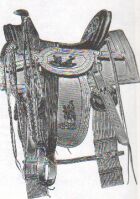
|
|
Every
privation which he endures, his horse endures with him -- carrying him through
falling weather, swimming rivers by day and riding in the lead of stampedes
at night, always faithful, always willing and always patiently enduring every
hardship from exhausting hours under saddle to the suffering of a dry drive.
|
|
|
Rearing horses
These are favourite means that writers use to separate riders from
horses, but the hero should not fall off a rearing horse as rears are not
hard to ride. An unexpected shy or a buck can be much harder to sit.
Horses do not rear if they see a snake. This writer has personally seen
two cases where horses stepped on snakes and did not react in any way. They
might have if the snakes had bitten them, but they seemed oblivious to the
reptiles' presence. Sighting the sudden movement of a snake might make a
horse shy but they do not rear or bolt.
Bucking horses
These were common in the West for various reasons but writers talk of horses
bucking for impossibly long periods. Bucking time is measured in seconds
rather than minutes. Bucking requires a great amount of energy and it is
a very good bucker that can buck hard for 10 seconds . Some will stop to
recover their breath and start again but they cannot keep going continuously.
A cowboy used to riding, who has a decent saddle, does not get saddle-sore.
Open wounds sometimes described, would not occur with the usual western
saddle. They are designed for rider comfort during long working days. Only
under unusual circumstances do experienced riders get saddle-sore.
Side-saddles, lame horses
Most ladies in the Wild West era rode side-saddle. A few rode astride but
it was considered unladylike and few did it in public.
The loss of a shoe does not automatically lame a horse and many ranch
horses were not shod. It just depended upon the country where they worked
and how much work they were given. Stone bruises are too often trivialised
in stories as being nothing very serious. Any stone bruise will put a horse
out of action once the injury cools. These bruises are very painful and in
the days before antibiotics, some took a year to get right. Tendon damage
is usually serious and in some cases permanent. Liniment was used on sprains
but was never used on open wounds.
Shot horses
Horses are large, powerful animals and can absorb quite powerful bullets
without being knocked off their feet. Most comparatively low-powered firearms
of the Wild West era would not kill a horse outright unless it struck the
brain or penetrated to the heart. A brain-shot horse drops immediately,
but one shot in the heart can gallop fifty yards or more before collapsing.
It was possible to empty a revolver into a horse with no apparent damage
to it although the animal would probably die a slow death later.
|

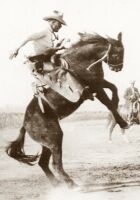
|
|
When the shooter is some distance from the horse, it is possible to hear
the sound of the bullet striking the animal.
Though we sometimes laugh at situations where heroes are rescued by their
faithful horses, a few such animals exist. In this old bloke's lifetime
I have had two horses that were fiercely protective of me and would attack
any horse or dog that they thought might harm me. Any human who threatened
me might also have found himself in trouble but such occasions never arose.
So protective horses do exist but they are not common. I doubt if either
of mine would have been smart enough to chew through ropes or do some of
the things that fictional heroes' horses sometimes do. I had another that
was very loyal to the extent that she defied the herd instinct and stayed
with me when other horses galloped away. But the majority of horses do not
show great powers of reasoning. Most are content to do the horse's job and
leave thinking work to others better qualified. Where horse and rider have
had a close association, it is possible that the animal might do something
unusual to protect the man, but remember -- horses are not Rhodes Scholars.
The western character is incomplete without a horse and these wonderful
animals can greatly enhance a story if references to them are correct. If
a writer is not sure about some aspect, it is safest to use general terms
rather than go into details that might sound right but do not really suit
the situation. It is a case of "different strokes for different folks". What
is right in show riding can be wrong or even dangerous in western situations.
Don't rely on the wrong books when doing research!
-- Paddy Gallagher, aka Greg Mitchell, whose next BHW,
Range Rustlers, will be published in April.
|
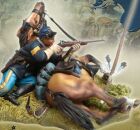

|
|
|
|
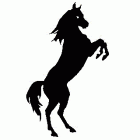
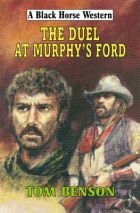
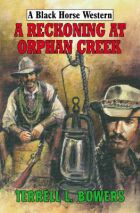
|
NEW
BLACK HORSE
WESTERN NOVELS
Published by Robert Hale Ltd, London
978
| Call Me Ringo
|
Hank J. Kirby
|
0 7090 8531 7
|
| Wrong Town
|
Matthew P. Mayo
|
0
7090 8511 9
|
Duel at Murphy's Ford
|
Tom Benson
|
0
7090 8519 5
|
The Long Chase
|
Alan Irwin |
0
7090 8527 0
|
Tough Justice
|
Skeeter Dodds
|
0
7090 8502 7
|
Saratoga
|
Jim Lawless
|
0
7090 8539 3
|
A Reckoning at Orphan Creek
|
Terrell L. Bowers
|
0
7090 8525 6
|
Misfit Lil Hides Out
|
Chap O'Keefe
|
0
7090 8352 8
|
Hell's Courtyard
|
Corba Sunman
|
0
7090 8491 4
|
Six Days to Sundown
|
Owen G. Irons
|
0
7090 8532 4
|
In the Name of the Gun
|
Ryan Bodie
|
0
7090 8543 0
|
The Death Trail
|
M. Duggan
|
0
7090 8545 4 |
Renegade Gold
|
Robert Anderson
|
0
7090 8547 8
|
Duel at Cheyenne
|
Daniel Rockfern
|
0
7090 7687 2
|
Blood Creek
|
Lance Howard
|
0
7090 8454 9
|
Wolf Hole
|
Abe Dancer
|
0
7090 8544 7
|
Lightning at the Hanging Tree
|
Mark Falcon
|
0
7090 8553 9
|
Temptation Trail
|
Billy Hall
|
0
7090 8554 6
|
Range Rustlers
|
Greg Mitchell
|
0 7090 8567 6
|
|
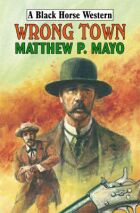
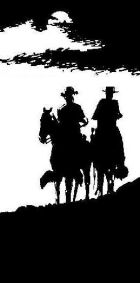
|
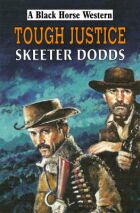
|
Black
Horse Westerns can be requested at public libraries, ordered at bookstores,
and bought online through the publisher's website, www.halebooks.com, or retailers including Amazon, Blackwells,
WH Smith and VinersUK Books.
Trade inquiries
to: Combined Book Services,
Units I/K, Paddock Wood Distribution
Centre,
Paddock Wood, Tonbridge, Kent TN12 6UU.
Tel: (+44) 01892 837 171 Fax: (+44)
01892 837 272
Email: orders@combook.co.uk
For Australian Trade Sales, contact DLS Distribution Services, tradesales@dlsbooks.com
For Australian & New Zealand Library Sales, contact DLS Library Services, swalters@dlsbooks.com
DLS Australia Pty Ltd, 12 Phoenix Court, Braeside, 3195, Australia.
Ph: (+61) 3 9587 5044 Fax: (+61) 3 9587 5088
|
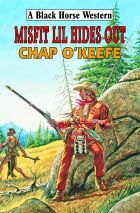
|
|
|
|
|